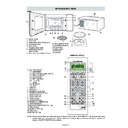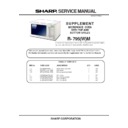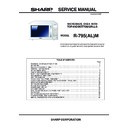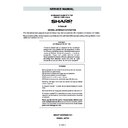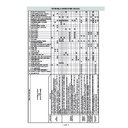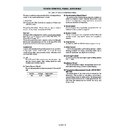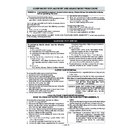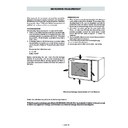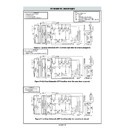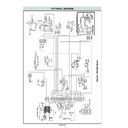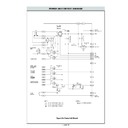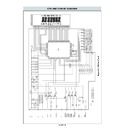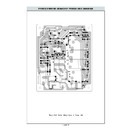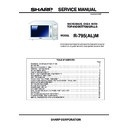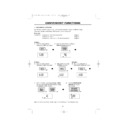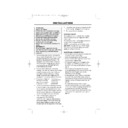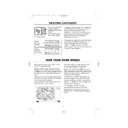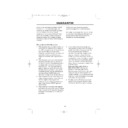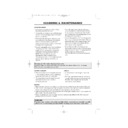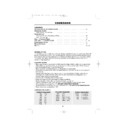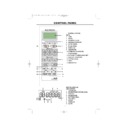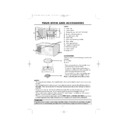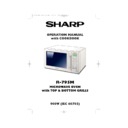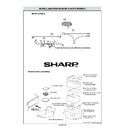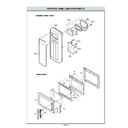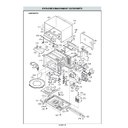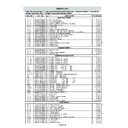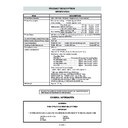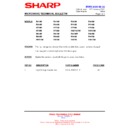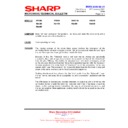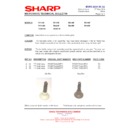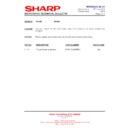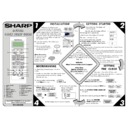Sharp R-795M (serv.man6) Service Manual ▷ View online
R-795M-
9
DOOR OPEN MECHANISM
The door can be opened by pulling the door handle. When
the handle is pulled, the latch head is pulled, the latch head
is moved upward, and released from the latch hook now
the door can be opened.
the handle is pulled, the latch head is pulled, the latch head
is moved upward, and released from the latch hook now
the door can be opened.
Figure D-1. Door Open Mechanism
MONITORED LATCH SWITCH
1. When the oven door is closed, the contacts (COM-NO)
of the switch must be closed. And the contacts (COM-
NC) must be opened.
NC) must be opened.
2. When the oven door is opened, the contacts (COM-
NO) of the switch must be opened. And the contacts
(COM-NC) must be closed.
(COM-NC) must be closed.
STOP SWITCH
1. When the oven door is closed, the contacts (COM-NO)
of the switch must be closed.
2. When the oven door is opened, the contacts (COM-
NO) of switch must be opened.
MONITOR SWITCH
The monitor switch is activated (the contacts opened) by the
upper latch head on the door while the door is closed. The
switch is intended to render the oven inoperative by means
of blowing the fuse F8A when the contacts of the monitored
latch switch fail to open when the door is opened.
Function
1. When the door is opened, the contacts (COM-NC) of
upper latch head on the door while the door is closed. The
switch is intended to render the oven inoperative by means
of blowing the fuse F8A when the contacts of the monitored
latch switch fail to open when the door is opened.
Function
1. When the door is opened, the contacts (COM-NC) of
monitor switch close (to the ON condition) due to their
being normally closed and contacts (COM-NO) open.
At this time the contacts (COM-NO) of monitored latch
switch is in the OFF condition (contacts open) due to
their being normally open contact switches.
being normally closed and contacts (COM-NO) open.
At this time the contacts (COM-NO) of monitored latch
switch is in the OFF condition (contacts open) due to
their being normally open contact switches.
2. As the door goes to a closed position, the monitor
switch SW3 contacts (COM-NC) are opened and con-
tacts (COM-NO) closed and then contacts (COM-NO)
of monitored latch switch and stop switch are closed.(On
opening the door, each of these switches operate
inversely.)
tacts (COM-NO) closed and then contacts (COM-NO)
of monitored latch switch and stop switch are closed.(On
opening the door, each of these switches operate
inversely.)
3. If the door is opened and the monitored latch switch
contacts (COM-NO) fail to open, the fuse F8A blows
immediately after closing of the monitor switch (COM-
NC) contacts.
immediately after closing of the monitor switch (COM-
NC) contacts.
CAUTION: BEFORE REPLACING A BLOWN FUSE F8A,
TEST THE MONITORED LATCH SWITCH
AND MONITOR SWITCH FOR PROPER
OPERATION. (REFER TO CHAPTER “TEST
PROCEDURE”).
AND MONITOR SWITCH FOR PROPER
OPERATION. (REFER TO CHAPTER “TEST
PROCEDURE”).
FUSE 15A 250V
If the wire harness or electrical components are short-
circuited, this fuse blows to prevent an electric shock of fire
hazard.
circuited, this fuse blows to prevent an electric shock of fire
hazard.
FUSE F8A 250V
1. If the wire harness or electrical components are short-
circuited, this fuse blows to prevent an electric shock or
fire hazard.
fire hazard.
2. The fuse also blows when the monitored latch switch
remains closed with the oven door open and when the
monitor switch contact (COM-NC) closes.
monitor switch contact (COM-NC) closes.
3. The fuse also blows when the asymmetric rectifier,
H.V. rectifier,H.V. wire harness, H.V. capacitor,
magnetron or secondary winding of high voltage trans-
former is shorted.
magnetron or secondary winding of high voltage trans-
former is shorted.
TC TRANSFORMER
T/C transformer converts A.C. line voltage into low voltage
to drive the control unit.
to drive the control unit.
THERMAL CUT-OUT 125˚C (MG)
This thermal cut-out protects the magnetron against over-
heat. If the temperature goes up higher than 125˚C be-
cause the fan motor is interrupted or the ventilation open-
ings are blocked, the thermal cut-out will open and line
voltage to the high voltage transformer will cut off and
operation of the magnetron will be stopped. The defec-
tive thermal cut-out must be replaced with a new one.
heat. If the temperature goes up higher than 125˚C be-
cause the fan motor is interrupted or the ventilation open-
ings are blocked, the thermal cut-out will open and line
voltage to the high voltage transformer will cut off and
operation of the magnetron will be stopped. The defec-
tive thermal cut-out must be replaced with a new one.
THERMAL CUT-OUT 145˚C (OVEN)
This thermal cut-out protects the oven against the over-
heat during grill cooking, oven cooking or dual (combina-
tion) cooking. If the temperature rises above 145˚C be-
cause the fan motor is interrupted, the air inlet duct is
blocked or the ventilation openings are obstructed, the
thermal cut-out opens and switches off all the electrical
parts. When the cools itself down to the operating tem-
perature of 115˚C, the contacts of the thermal cut-out will
close again.
heat during grill cooking, oven cooking or dual (combina-
tion) cooking. If the temperature rises above 145˚C be-
cause the fan motor is interrupted, the air inlet duct is
blocked or the ventilation openings are obstructed, the
thermal cut-out opens and switches off all the electrical
parts. When the cools itself down to the operating tem-
perature of 115˚C, the contacts of the thermal cut-out will
close again.
ASYMMETRIC RECTIFIER
The asymmetric rectifier is solid state device that prevents
current flow is both directions. And it prevents the tem-
perature rise of the high voltage transformer by blowing
the fuseF8A when the high voltage rectifier is shorted.
current flow is both directions. And it prevents the tem-
perature rise of the high voltage transformer by blowing
the fuseF8A when the high voltage rectifier is shorted.
The rated peak reverse voltage of D1 of the asymmetric
rectifier is 6 KV. The rated peak reverse voltage of D2 of
the asymmetric rectifier is 1.7 KV. D1 and D2 of the
rectifier is 6 KV. The rated peak reverse voltage of D2 of
the asymmetric rectifier is 1.7 KV. D1 and D2 of the
FUNCTION OF IMPORTANT COMPONENTS
asymmetric rectifier or high voltage rectifier are shorted
when the each peak reverse voltage goes beyond the
each rated peak reverse voltage. (The process of the
blowing the fuseF8A.)
when the each peak reverse voltage goes beyond the
each rated peak reverse voltage. (The process of the
blowing the fuseF8A.)
Latch hook
Door
SW2: Stop switch
Latch
Heads
Heads
SW3: Monitor switch
SW1: Monitored
latch switch
Tab
D2
D1
ASYMMETRIC
RECTIFIER
RECTIFIER
HIGH VOLTAGE RECTIFIER
R-795M
-
10
FUNCTION OF IMPORTANT COMPONENTS
the selected temperature.
When the oven cooking time reaches “0”, the heating
elements are de-energized and the oven shuts off. At that
time if the cavity air temperature has rised above120˚C,
the fan motor remains rotating. Automatically the fan
motor will be shut down at low temperature (less than
105˚C).
When the oven cooking time reaches “0”, the heating
elements are de-energized and the oven shuts off. At that
time if the cavity air temperature has rised above120˚C,
the fan motor remains rotating. Automatically the fan
motor will be shut down at low temperature (less than
105˚C).
FIRE SENSING FEATURE
The oven will stop its operation when there is a fire in the
oven cavity in microwave cooking condition.
LSI measures the voltage across the temperature meas-
urement circuit intermittently within 32-seconds time base
since the oven is started in microwave cooking condition.
The oven will stop its operation when the difference of the
voltage is more than 0.781 volts in microwave cooking
condition.
1. Within a 32-seconds base, the thermistor is energized
oven cavity in microwave cooking condition.
LSI measures the voltage across the temperature meas-
urement circuit intermittently within 32-seconds time base
since the oven is started in microwave cooking condition.
The oven will stop its operation when the difference of the
voltage is more than 0.781 volts in microwave cooking
condition.
1. Within a 32-seconds base, the thermistor is energized
for 2 seconds. At that time, the voltage across the
temperature measurement circuit is measured.
temperature measurement circuit is measured.
2. The oven carries out the procedure above again. If the
second voltage is 0.781V higher than first voltage, LSI
judges it is a fire in the oven cavity and stop the oven.
judges it is a fire in the oven cavity and stop the oven.
3. When LSI judges it is a fire in the oven cavity, LSI will
switch off the relays to high voltage transformer and fan
motor and LSI stops countring down.
motor and LSI stops countring down.
OPEN JUDGE BY THERMISTOR
1. If the temperature of the thermistor does not rise to
more than 40˚C after 4 minutes and 15 seconds from
when the oven is started in oven cooking mode, dual
cooking mode or grill (top and bottom) cooking mode,
the oven is turned off.
when the oven is started in oven cooking mode, dual
cooking mode or grill (top and bottom) cooking mode,
the oven is turned off.
2. When the thermistor or the wire harness to the thermis-
tor is opened, the oven is turned off after 4 minutes and
15 seconds because this condition is same as above.
15 seconds because this condition is same as above.
1. The high voltage rectifier is shorted by some fault when
microwave cooking or dual cooking.
2. The peak reverse voltage of D2 of the rectifier goes
beyond the rated peak reverse voltage 1.7 KV in the
voltage doubler circuit.
voltage doubler circuit.
3. D2 of the rectifier is shorted.
4. The large electric currents flow through the high volt-
4. The large electric currents flow through the high volt-
age winding of the high voltage transformer.
5. The large electric currents beyond 8A flow through the
primary winding of the high voltage transformer.
6. The fuse F8A blows by the large electric currents.
7. The power supplying to the high voltage transformer is
7. The power supplying to the high voltage transformer is
cut off.
NOISE FILTER
The noise filter assembly prevents radio frequency inter-
ference that might flow back in the power circuit.
ference that might flow back in the power circuit.
TURNTABLE MOTOR
The turntable motor rotates the turntable.
FAN MOTOR
The fan motor drives a blade which draws external cool air.
This cool air is directed through the air vanes surrounding
the magnetron and cools the magnetron. This air is chan-
nelled through the oven cavity to remove steam and
vapours given off from heating food. It is then exhausted
through the exhausting air vents of the oven cavity.
This cool air is directed through the air vanes surrounding
the magnetron and cools the magnetron. This air is chan-
nelled through the oven cavity to remove steam and
vapours given off from heating food. It is then exhausted
through the exhausting air vents of the oven cavity.
TOP GRILL HEATING ELEMENT
The grill heating element is provided to brown the food and
is located on the top of the oven cavity.
is located on the top of the oven cavity.
BOTTOM GRILL HEATING ELEMENT
The grill heating element is provided to brown the food and
is located at the base of the oven cavity.
is located at the base of the oven cavity.
OVEN COOKING SYSTEM
Food is cooked by the top and bottom heating elements.
And the temperature of the oven cavity can be controlled
by the thermistor circuit. When the temperature inside the
oven cavity reaches the selected temperature, the heating
elements are de-energized. When the temperature inside
the oven cavity drops below the selected temperature, the
heating elements are energized again. In this way, the
inside of the oven cavity is maintained at approximately
And the temperature of the oven cavity can be controlled
by the thermistor circuit. When the temperature inside the
oven cavity reaches the selected temperature, the heating
elements are de-energized. When the temperature inside
the oven cavity drops below the selected temperature, the
heating elements are energized again. In this way, the
inside of the oven cavity is maintained at approximately
TROUBLESHOOTING GUIDE
When troubleshooting the microwave oven, it is helpful to follow the Sequence of Operation in performing the checks.
Many of the possible causes of trouble will require that a specific test be performed. These tests are given a procedure
letter which will be found in the “Test Procedure” section.
Many of the possible causes of trouble will require that a specific test be performed. These tests are given a procedure
letter which will be found in the “Test Procedure” section.
IMPORTANT: If the oven becomes inoperative because of a blown fuse (F8A) in the monitored latch switch - monitor
switch circuit, check the monitored latch switch and monitor switch before replacing the fuse (F8A).
THERMISTOR
SENSING
VOLTAGE
ON
OFF
ON
OFF
30
32 (sec.)
Sensing the voltage across temperature measurement circuit.
R-795M
-
10
FUNCTION OF IMPORTANT COMPONENTS
the selected temperature.
When the oven cooking time reaches “0”, the heating
elements are de-energized and the oven shuts off. At that
time if the cavity air temperature has rised above120˚C,
the fan motor remains rotating. Automatically the fan
motor will be shut down at low temperature (less than
105˚C).
When the oven cooking time reaches “0”, the heating
elements are de-energized and the oven shuts off. At that
time if the cavity air temperature has rised above120˚C,
the fan motor remains rotating. Automatically the fan
motor will be shut down at low temperature (less than
105˚C).
FIRE SENSING FEATURE
The oven will stop its operation when there is a fire in the
oven cavity in microwave cooking condition.
LSI measures the voltage across the temperature meas-
urement circuit intermittently within 32-seconds time base
since the oven is started in microwave cooking condition.
The oven will stop its operation when the difference of the
voltage is more than 0.781 volts in microwave cooking
condition.
1. Within a 32-seconds base, the thermistor is energized
oven cavity in microwave cooking condition.
LSI measures the voltage across the temperature meas-
urement circuit intermittently within 32-seconds time base
since the oven is started in microwave cooking condition.
The oven will stop its operation when the difference of the
voltage is more than 0.781 volts in microwave cooking
condition.
1. Within a 32-seconds base, the thermistor is energized
for 2 seconds. At that time, the voltage across the
temperature measurement circuit is measured.
temperature measurement circuit is measured.
2. The oven carries out the procedure above again. If the
second voltage is 0.781V higher than first voltage, LSI
judges it is a fire in the oven cavity and stop the oven.
judges it is a fire in the oven cavity and stop the oven.
3. When LSI judges it is a fire in the oven cavity, LSI will
switch off the relays to high voltage transformer and fan
motor and LSI stops countring down.
motor and LSI stops countring down.
OPEN JUDGE BY THERMISTOR
1. If the temperature of the thermistor does not rise to
more than 40˚C after 4 minutes and 15 seconds from
when the oven is started in oven cooking mode, dual
cooking mode or grill (top and bottom) cooking mode,
the oven is turned off.
when the oven is started in oven cooking mode, dual
cooking mode or grill (top and bottom) cooking mode,
the oven is turned off.
2. When the thermistor or the wire harness to the thermis-
tor is opened, the oven is turned off after 4 minutes and
15 seconds because this condition is same as above.
15 seconds because this condition is same as above.
1. The high voltage rectifier is shorted by some fault when
microwave cooking or dual cooking.
2. The peak reverse voltage of D2 of the rectifier goes
beyond the rated peak reverse voltage 1.7 KV in the
voltage doubler circuit.
voltage doubler circuit.
3. D2 of the rectifier is shorted.
4. The large electric currents flow through the high volt-
4. The large electric currents flow through the high volt-
age winding of the high voltage transformer.
5. The large electric currents beyond 8A flow through the
primary winding of the high voltage transformer.
6. The fuse F8A blows by the large electric currents.
7. The power supplying to the high voltage transformer is
7. The power supplying to the high voltage transformer is
cut off.
NOISE FILTER
The noise filter assembly prevents radio frequency inter-
ference that might flow back in the power circuit.
ference that might flow back in the power circuit.
TURNTABLE MOTOR
The turntable motor rotates the turntable.
FAN MOTOR
The fan motor drives a blade which draws external cool air.
This cool air is directed through the air vanes surrounding
the magnetron and cools the magnetron. This air is chan-
nelled through the oven cavity to remove steam and
vapours given off from heating food. It is then exhausted
through the exhausting air vents of the oven cavity.
This cool air is directed through the air vanes surrounding
the magnetron and cools the magnetron. This air is chan-
nelled through the oven cavity to remove steam and
vapours given off from heating food. It is then exhausted
through the exhausting air vents of the oven cavity.
TOP GRILL HEATING ELEMENT
The grill heating element is provided to brown the food and
is located on the top of the oven cavity.
is located on the top of the oven cavity.
BOTTOM GRILL HEATING ELEMENT
The grill heating element is provided to brown the food and
is located at the base of the oven cavity.
is located at the base of the oven cavity.
OVEN COOKING SYSTEM
Food is cooked by the top and bottom heating elements.
And the temperature of the oven cavity can be controlled
by the thermistor circuit. When the temperature inside the
oven cavity reaches the selected temperature, the heating
elements are de-energized. When the temperature inside
the oven cavity drops below the selected temperature, the
heating elements are energized again. In this way, the
inside of the oven cavity is maintained at approximately
And the temperature of the oven cavity can be controlled
by the thermistor circuit. When the temperature inside the
oven cavity reaches the selected temperature, the heating
elements are de-energized. When the temperature inside
the oven cavity drops below the selected temperature, the
heating elements are energized again. In this way, the
inside of the oven cavity is maintained at approximately
TROUBLESHOOTING GUIDE
When troubleshooting the microwave oven, it is helpful to follow the Sequence of Operation in performing the checks.
Many of the possible causes of trouble will require that a specific test be performed. These tests are given a procedure
letter which will be found in the “Test Procedure” section.
Many of the possible causes of trouble will require that a specific test be performed. These tests are given a procedure
letter which will be found in the “Test Procedure” section.
IMPORTANT: If the oven becomes inoperative because of a blown fuse (F8A) in the monitored latch switch - monitor
switch circuit, check the monitored latch switch and monitor switch before replacing the fuse (F8A).
THERMISTOR
SENSING
VOLTAGE
ON
OFF
ON
OFF
30
32 (sec.)
Sensing the voltage across temperature measurement circuit.
R-795M
-
10
FUNCTION OF IMPORTANT COMPONENTS
the selected temperature.
When the oven cooking time reaches “0”, the heating
elements are de-energized and the oven shuts off. At that
time if the cavity air temperature has rised above120˚C,
the fan motor remains rotating. Automatically the fan
motor will be shut down at low temperature (less than
105˚C).
When the oven cooking time reaches “0”, the heating
elements are de-energized and the oven shuts off. At that
time if the cavity air temperature has rised above120˚C,
the fan motor remains rotating. Automatically the fan
motor will be shut down at low temperature (less than
105˚C).
FIRE SENSING FEATURE
The oven will stop its operation when there is a fire in the
oven cavity in microwave cooking condition.
LSI measures the voltage across the temperature meas-
urement circuit intermittently within 32-seconds time base
since the oven is started in microwave cooking condition.
The oven will stop its operation when the difference of the
voltage is more than 0.781 volts in microwave cooking
condition.
1. Within a 32-seconds base, the thermistor is energized
oven cavity in microwave cooking condition.
LSI measures the voltage across the temperature meas-
urement circuit intermittently within 32-seconds time base
since the oven is started in microwave cooking condition.
The oven will stop its operation when the difference of the
voltage is more than 0.781 volts in microwave cooking
condition.
1. Within a 32-seconds base, the thermistor is energized
for 2 seconds. At that time, the voltage across the
temperature measurement circuit is measured.
temperature measurement circuit is measured.
2. The oven carries out the procedure above again. If the
second voltage is 0.781V higher than first voltage, LSI
judges it is a fire in the oven cavity and stop the oven.
judges it is a fire in the oven cavity and stop the oven.
3. When LSI judges it is a fire in the oven cavity, LSI will
switch off the relays to high voltage transformer and fan
motor and LSI stops countring down.
motor and LSI stops countring down.
OPEN JUDGE BY THERMISTOR
1. If the temperature of the thermistor does not rise to
more than 40˚C after 4 minutes and 15 seconds from
when the oven is started in oven cooking mode, dual
cooking mode or grill (top and bottom) cooking mode,
the oven is turned off.
when the oven is started in oven cooking mode, dual
cooking mode or grill (top and bottom) cooking mode,
the oven is turned off.
2. When the thermistor or the wire harness to the thermis-
tor is opened, the oven is turned off after 4 minutes and
15 seconds because this condition is same as above.
15 seconds because this condition is same as above.
1. The high voltage rectifier is shorted by some fault when
microwave cooking or dual cooking.
2. The peak reverse voltage of D2 of the rectifier goes
beyond the rated peak reverse voltage 1.7 KV in the
voltage doubler circuit.
voltage doubler circuit.
3. D2 of the rectifier is shorted.
4. The large electric currents flow through the high volt-
4. The large electric currents flow through the high volt-
age winding of the high voltage transformer.
5. The large electric currents beyond 8A flow through the
primary winding of the high voltage transformer.
6. The fuse F8A blows by the large electric currents.
7. The power supplying to the high voltage transformer is
7. The power supplying to the high voltage transformer is
cut off.
NOISE FILTER
The noise filter assembly prevents radio frequency inter-
ference that might flow back in the power circuit.
ference that might flow back in the power circuit.
TURNTABLE MOTOR
The turntable motor rotates the turntable.
FAN MOTOR
The fan motor drives a blade which draws external cool air.
This cool air is directed through the air vanes surrounding
the magnetron and cools the magnetron. This air is chan-
nelled through the oven cavity to remove steam and
vapours given off from heating food. It is then exhausted
through the exhausting air vents of the oven cavity.
This cool air is directed through the air vanes surrounding
the magnetron and cools the magnetron. This air is chan-
nelled through the oven cavity to remove steam and
vapours given off from heating food. It is then exhausted
through the exhausting air vents of the oven cavity.
TOP GRILL HEATING ELEMENT
The grill heating element is provided to brown the food and
is located on the top of the oven cavity.
is located on the top of the oven cavity.
BOTTOM GRILL HEATING ELEMENT
The grill heating element is provided to brown the food and
is located at the base of the oven cavity.
is located at the base of the oven cavity.
OVEN COOKING SYSTEM
Food is cooked by the top and bottom heating elements.
And the temperature of the oven cavity can be controlled
by the thermistor circuit. When the temperature inside the
oven cavity reaches the selected temperature, the heating
elements are de-energized. When the temperature inside
the oven cavity drops below the selected temperature, the
heating elements are energized again. In this way, the
inside of the oven cavity is maintained at approximately
And the temperature of the oven cavity can be controlled
by the thermistor circuit. When the temperature inside the
oven cavity reaches the selected temperature, the heating
elements are de-energized. When the temperature inside
the oven cavity drops below the selected temperature, the
heating elements are energized again. In this way, the
inside of the oven cavity is maintained at approximately
TROUBLESHOOTING GUIDE
When troubleshooting the microwave oven, it is helpful to follow the Sequence of Operation in performing the checks.
Many of the possible causes of trouble will require that a specific test be performed. These tests are given a procedure
letter which will be found in the “Test Procedure” section.
Many of the possible causes of trouble will require that a specific test be performed. These tests are given a procedure
letter which will be found in the “Test Procedure” section.
IMPORTANT: If the oven becomes inoperative because of a blown fuse (F8A) in the monitored latch switch - monitor
switch circuit, check the monitored latch switch and monitor switch before replacing the fuse (F8A).
THERMISTOR
SENSING
VOLTAGE
ON
OFF
ON
OFF
30
32 (sec.)
Sensing the voltage across temperature measurement circuit.
Display

